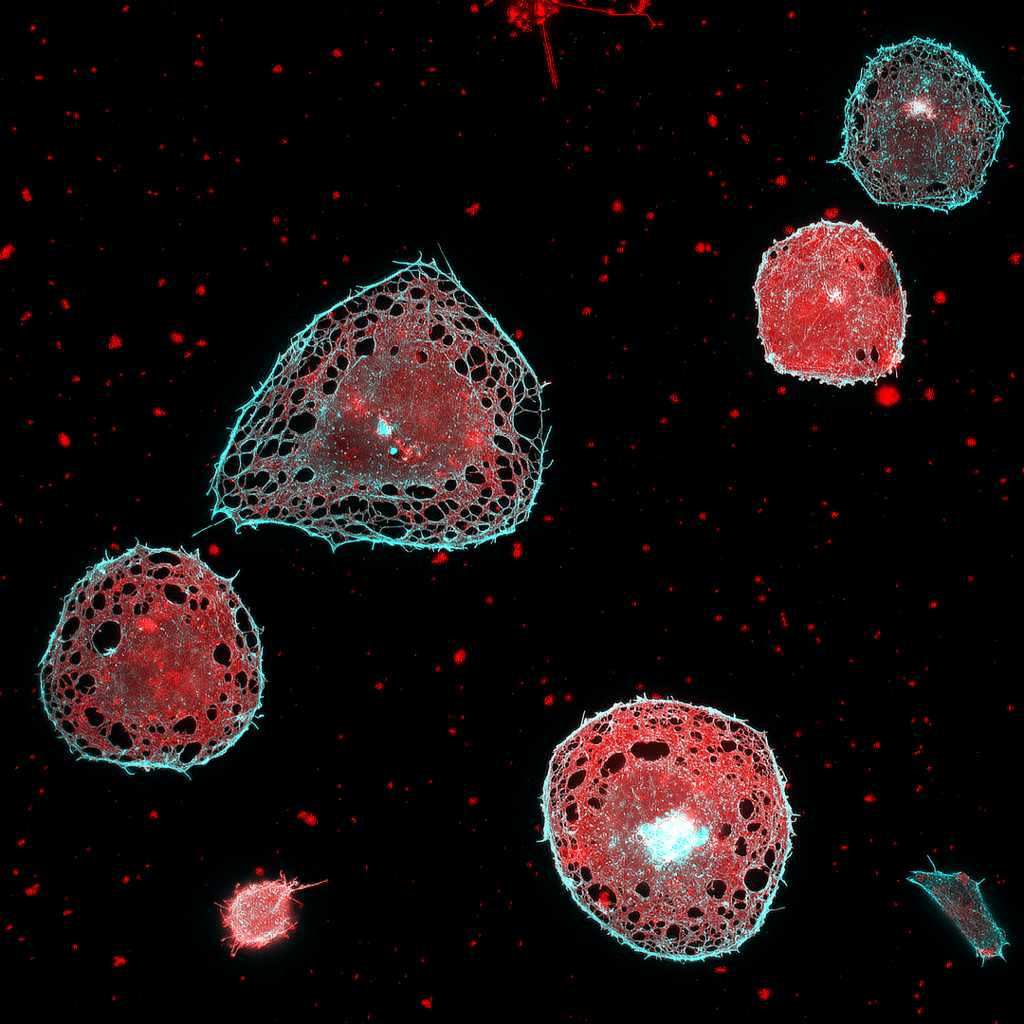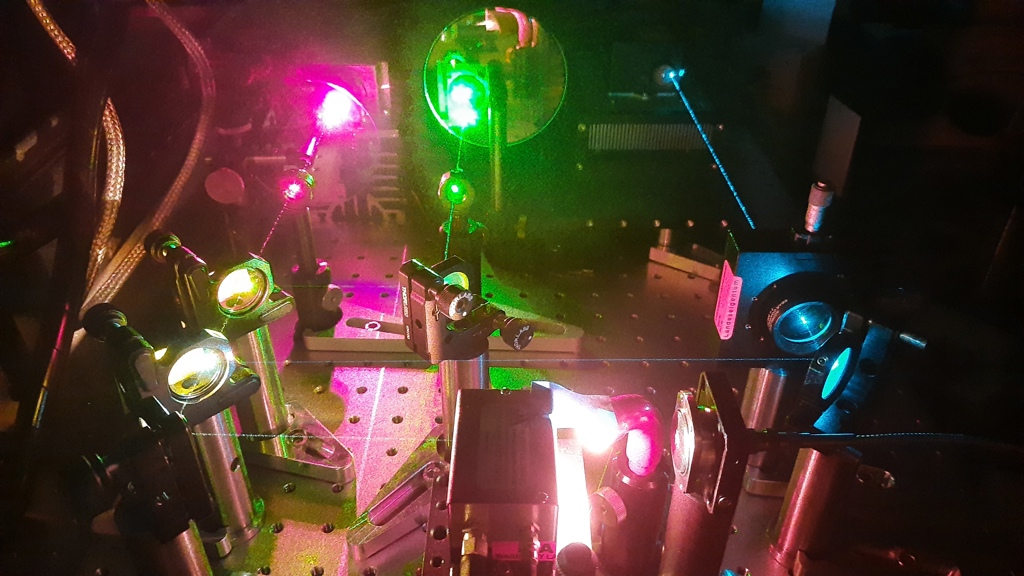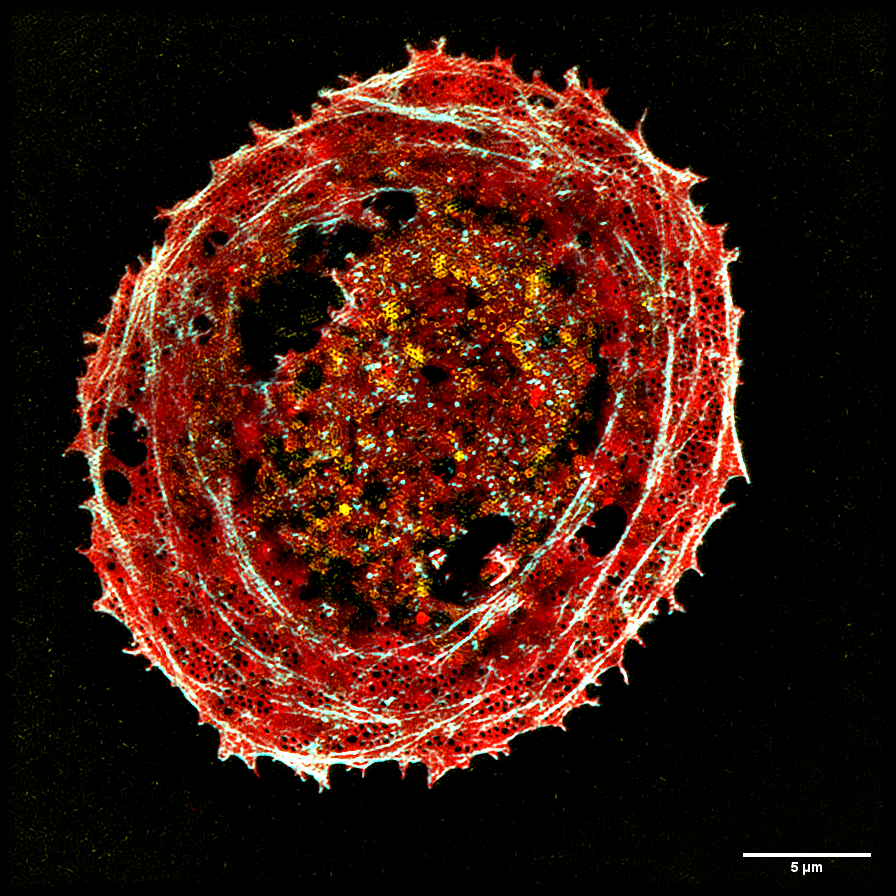About
16 August 2023
Researchers achieve high-speed super-resolution imaging with a large field of view
Microscope based on fiberoptic components designed for studying cellular effects of drug combinations

Caption: Thanks to the microscope’s large field of view, it is possible to acquire super-resolution images of multiple cells at once.
Credit: Henning Ortkrass, Bielefeld University
WASHINGTON — Researchers have developed a fluorescence microscope that uses structured illumination for fast super-resolution imaging over a wide field of view. The new microscope was designed to image multiple living cells simultaneously with a very high resolution to study the effects of various drugs and mixtures of drugs on the body.
“Polypharmacy — the effect of the many combinations of drugs typically prescribed to the chronically sick or elderly — can lead to dangerous interactions and is becoming a major issue,” said Henning Ortkrass from Bielefeld University in Germany. “We developed this microscope as part of the EIC Pathfinder OpenProject DeLIVERy, which aims to develop a platform that can investigate polypharmacy in individual patients.”
In the Optica Publishing Group journal Optics Express, the researchers describe their new microscope which uses optical fiber delivery of excitation light to enable very high image quality over a very large field of view with multicolor and high-speed capability. They show that the instrument can be used to image liver cells, achieving a field of view up to 150 x 150 μm² and imaging rates up to 44 Hz while maintaining a spatiotemporal resolution of less than 100 nm.
“With this new microscope, individual drug combinations can be tested on isolated cells and then imaged with super-resolution to observe dynamics of cell membrane features or organelles,” said Ortkrass. “The large field of view can provide statistical information about the cell response, which could be used to improve personalized healthcare. Thanks to the system’s potentially small size, it might also be useful for clinical applications where high resolution is important.”

Caption: Researchers developed a fluorescence microscope that uses structured illumination for fast super-resolution imaging over a wide field of view. It can also be used for multicolor and high-speed imaging.
Credit: Henning Ortkrass, Bielefeld University
High resolution across a large field of view
The new microscope is based on super-resolved structured illumination microscopy (SR-SIM), which uses a structured pattern of light to excite fluorescence in a sample and achieve a spatial resolution beyond the diffraction limit of light. SR-SIM is particularly well suited for live cell imaging because it uses low-power excitation that doesn’t harm the sample while producing highly detailed images.
To achieve high resolution across a wide field of view, the new microscope reconstructs super-resolved images from a set of raw images. These raw images are acquired by using a set of six optical fibers to illuminate the sample with a sinusoidal striped pattern that is shifted and rotated to gain extra information. This creates a two-fold resolution improvement while still achieving fast imaging and being compatible with live-cell imaging.
“The fiber selection and phase shift is performed using a newly designed fiber switch based on galvanometric mirrors and MEMS-mirrors,” said Ortkrass. “We also custom-designed a hexagonal holder that collimates and refocuses the beams of the six fibers into the microscope to illuminate a large FOV and allow precise adjustment of all beams. This allows the setup to be used for total internal reflection fluorescence excitation (TIRF)-SIM, which is used to restrict fluorescence excitation and detection to a thin region of the sample.”

Caption: The researchers used their new microscopy setup to image fixed multicolor-stained liver cells. The image showed the cells’ tiny membrane structures, which are smaller than the diffraction limit of light.
Credit: Henning Ortkrass, Bielefeld University
Imaging liver cells
Since the liver is the primary organ involved in drug metabolism, the researchers tested the setup using samples of fixed multicolor-stained rat liver cells. The reconstructed images produced with the new microscope allowed visualization of the tiny membrane structures that are smaller than the diffraction limit of light.
“This compact system uniquely combines a large field of view and fast pattern switching speed with multicolor, power-efficient excitation,” said Ortkrass. “In addition, the setup achieves very high image quality and can be tuned to perform either 2D-SIM or TIRF-SIM.”
Next, the researchers plan to apply the microscopy setup to live cell studies of liver cells to observe the dynamics of cells treated with several drugs. They also plan to improve the image reconstruction process to accomplish live reconstruction of the acquired raw data.
Paper: H. Ortkrass, J. Schürstedt, G. Wiebuch, K. Szafranska, P. McCourt, T. Huser, “High-speed TIRF and 2D super-resolution structured illumination microscopy with large field of view based on fiber optic components,” Opt. Express, Vol. 31, Issue 18, pp. 29156-29165 (2023).
DOI: https://doi.org/10.1364/OE.495353
About Optica Publishing Group
Optica Publishing Group is a division of the society, Optica, Advancing Optics and Photonics Worldwide. It publishes the largest collection of peer-reviewed and most-cited content in optics and photonics, including 18 prestigious journals, the society’s flagship member magazine, and papers and videos from more than 835 conferences. With over 400,000 journal articles, conference papers and videos to search, discover and access, our publications portfolio represents the full range of research in the field from around the globe.
About Optics Express
Optics Express reports on scientific and technology innovations in all aspects of optics and photonics. The bi-weekly journal provides rapid publication of original, peer-reviewed papers. It is published by Optica Publishing Group and led by Editor-in-Chief James Leger of the University of Minnesota, USA. Optics Express is an open-access journal and is available at no cost to readers online. For more information, visit Optics Express.
Media Contact
